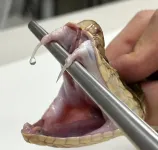(Press-News.org) Men with enlarged breast tissue, not caused by excess weight—a condition formally known as gynaecomastia—may be at heightened risk of an early death before the age of 75, suggests the first study of its kind, published online in the open access journal BMJ Open.
Those with a pre-existing risk factor, such as cancer or circulatory, lung, and gut diseases before diagnosis seem to be most vulnerable, the findings indicate.
Enlarged breast tissue in men is usually caused by a hormone imbalance and affects around a third to around two thirds of men, depending on age. It is distinct from what is often dubbed ‘man boobs’ (pseudogynecomastia), usually associated with overweight/obesity.
The development of gynaecomastia can occur at any age, but has three distinct peaks across the life course, prompted by pronounced changes in sex hormone levels in the neonatal period, during puberty, and at older ages, note the researchers.
It is most common at older ages, however, as testosterone levels decline, and is often accompanied by weight gain, which in turn can make it worse.
Previously published research indicates a link between the condition and a heightened risk of past and future risk of ill health. But it’s not clear if gynaecomastia is similarly associated with a heightened risk of death.
To try and find out, the researchers drew on data from Danish national health and population registries: 23,429 men were diagnosed with gynaecomastia between 1 January 1995 and 30 June 2021. Just over 44% were aged between 19 and 40 at diagnosis.
They were each matched by age and date of diagnosis with 5 randomly selected men without the condition (117,145; the reference group), adding up to a total of 140,574.
The men with gynaecomastia were further divided into 2 groups: those with idiopathic (unknown cause) gynaecomastia (16,253); and those with a known pre-existing condition or taking medication associated with gynaecomastia (7,176).
They were all monitored from the date of study entry to death or the end of June 2021, whichever came first. In all, 12, 676 (9%) men died during the monitoring period.
Among those with gynaecomastia, 1093 (nearly 7%) with the condition of unknown cause and 1501 (21%) of those with a pre-existing risk factor died, compared with 10,532 (9%) deaths among the men without gynaecomastia.
This equates to a 37% higher risk of early death from any cause among those with gynaecomastia than among those without the condition.
But when stratified by group, the risk of death was highest in those with a known pre-existing condition among whom the odds were 75% higher than those with gynaecomastia of unknown cause among whom the odds were 5% higher.
Pre-existing cancers (74% heightened risk) and circulatory (61% heightened risk), lung (double the risk), and gut diseases (5-fold heightened risk) were associated with the greatest risks. But neurological disease was associated with a 29% lower risk.
Among individual cancers, those of the digestive tract (39% heightened risk), genitalia (3-fold greater risk), and lymph system (doubling in risk) were associated with the greatest risks.
Among the category of gut diseases, those of the liver (12-fold heightened risk) and disorders of the gallbladder, biliary tract, and pancreas (14-fold heightened risk) were associated with the greatest risks.
Men with idiopathic gynaecomastia weren’t generally at greater risk of an early death than men in the reference group, except for a cause-specific 2-fold heightened risk of death from liver disease.
This is an observational study, and as such, can’t establish causal factors, and the researchers acknowledge that they weren’t able to account for potentially influential factors, such as obesity, exposure to endocrine-disrupting chemicals, and steroid use.
By way of an explanation for their findings, the researchers suggest that gynaecomastia is strongly intertwined with later health risks, and quite possibly, the drugs used to treat them.
They conclude: “Males diagnosed with gynaecomastia are at a 37% higher risk of death, observed mainly in males with a known pre-existing gynaecomastia risk factor and not in males with idiopathic gynaecomastia. These results should therefore prompt thorough clinical examination to identify the underlying risk factors.”
END
Enlarged breast tissue in men (gynaecomastia) linked to heightened risk of death
Those with a pre-existing risk factor most vulnerable, research suggests
2024-01-17
ELSE PRESS RELEASES FROM THIS DATE:
Same-level workplace falls set to rise amid surge in older female workforce numbers
2024-01-17
Same-level falls in the workplace are set to rise amid rapid growth in the numbers of older female employees in the workforce, suggests Australian research published online first in the journal Occupational & Environmental Medicine.
Although workplace falls, overall, are more common among male employees, particularly falls from height, same-level falls are more common in older women, the findings indicate.
The prevalence and relative severity of workplace falls mean that better prevention strategies are needed to mitigate these sex-specific risk factors, conclude the researchers.
In 2016, an estimated 1.53 million deaths and 76.1 million years of ...
Silkmoths: Different olfactory worlds of females and males
2024-01-17
The world smells different for female silkmoths than for males
In humans, the sense of smell is similarly developed in men and women, although women have slightly more olfactory neurons and therefore a slightly more sensitive nose. On the whole, however, they perceive the same odors. Male moths, on the other hand, live in a completely different olfactory world to their female counterparts. For example, the antennae of male silkmoths - their "nose" - are highly specialized to detect female sex pheromones, ...
Wrongly-enforced rules over “digital surrogates” by museums censors research and creative use, study warns
2024-01-17
Cultural institutions are censoring research, learning and creativity because of the way they police the reuse of digital copies of out-of-copyright artworks and artefacts, a new study warns.
Cultural institutions have created a “mess” by claiming and enforcing new rights over the reproduction images of works in their collections.
This allows museums and other organisations to refuse requests for the use of the images in education or research or charge high fees. This impedes free and creative expression and amounts to censorship, according to Dr Andrea Wallace from the University of Exeter Law School.
Researchers, educators and others regularly ...
Space solar power project ends first in-space mission with successes and lessons
2024-01-17
One year ago, Caltech’s Space Solar Power Demonstrator (SSPD-1) launched into space to demonstrate and test three technological innovations that are among those necessary to make space solar power a reality.
The spaceborne testbed demonstrated the ability to beam power wirelessly in space; it measured the efficiency, durability, and function of a variety of different types of solar cells in space; and gave a real-world trial of the design of a lightweight deployable structure to deliver and hold the aforementioned solar cells and power transmitters.
Now, with ...
Pediatric Cancer Research Foundation launches 2024 call for entries for scholarships for pediatric cancer survivors
2024-01-17
The Pediatric Cancer Research Foundation today announced a call for entries for its 2024 Cancer Survivor Scholarships. The Foundation will award $100,000 to eligible students – including graduating high school seniors, college, vocational and graduate students – to support these students in realizing happy, productive futures. “Beating cancer medically is just one part of creating a healthy, happy life. Achieving our purpose of ensuring survivors can spread their wings and soar requires ...
Novel drug for fatal type of heart failure proves safe and effective in phase 3 trial
2024-01-17
Pumping over 100,000 times a day, the heart is a critical muscle needed to deliver oxygen and nutrients to our organs to sustain healthy bodily function. Unfortunately, heart failure affects an estimated 6.2 million people in the U.S. and a staggering 64 million worldwide.
Of older patients with heart failure and abnormally thickened hearts, as many as one in five have an underdiagnosed, highly progressive and fatal condition called transthyretin amyloid cardiomyopathy, or ATTR-CM. The disease, which can be hereditary or develop spontaneously, is defined by an accumulation of misfolded transthyretin ...
Study reveals a reaction at the heart of many renewable energy technologies
2024-01-16
CAMBRIDGE, MA — A key chemical reaction — in which the movement of protons between the surface of an electrode and an electrolyte drives an electric current — is a critical step in many energy technologies, including fuel cells and the electrolyzers used to produce hydrogen gas.
For the first time, MIT chemists have mapped out in detail how these proton-coupled electron transfers happen at an electrode surface. Their results could help researchers design more efficient fuel cells, batteries, or other energy technologies.
“Our advance in this paper was studying and understanding the nature of how these electrons and protons couple ...
Water as a nonlinear medium for ultrabroadband white laser
2024-01-16
Scientists are making significant strides in the development of ultrabroadband white laser sources, covering a wide spectrum from ultraviolet to far infrared. These lasers find applications in diverse fields such as large-scale imaging, femto-chemistry, telecommunications, laser spectroscopy, sensing, and ultrafast sciences.
However, the pursuit faces challenges, particularly in the selection of appropriate nonlinear mediums. Traditional solid materials, while efficient, are prone to optical damage under high peak power conditions. Gas mediums, though ...
Ultrafast laser pulses could lessen data storage energy needs
2024-01-16
A discovery from an experiment with magnets and lasers could be a boon to energy-efficient data storage.
“We wanted to study the physics of light-magnet interaction,” said Rahul Jangid, who led the data analysis for the project while earning his Ph.D. in materials science and engineering at UC Davis under associate professor Roopali Kukreja. “What happens when you hit a magnetic domain with very short pulses of laser light?”
Domains are areas within a magnet that flip from north to south poles. This property is used for ...
Tests can reveal whether an antibody can turn into a killer
2024-01-16
What makes a soldier switch sides? That is a really good question. Especially when the soldier is an antibody that is supposed to defend the body against one of the world's most dangerous snake venoms but instead ends up helping the venom kill the body.
The question has become topical after a group of DTU researchers slightly changed how they tested an antibody that had previously proven promising as an antidote to snake venom. In the first experiment on mice, the damaging effect on muscle tissue from the venom of Bothrops Asper, ...
LAST 30 PRESS RELEASES:
American Meteorological Society announces Rick Spinrad as 2026 President-Elect
Biomass-based carbon capture spotlighted in newly released global climate webinar recording
Illuminating invisible nano pollutants: advanced bioimaging tracks the full journey of emerging nanoscale contaminants in living systems
How does age affect recovery from spinal cord injury?
Novel AI tool offers prognosis for patients with head and neck cancer
Fathers’ microplastic exposure tied to their children’s metabolic problems
Research validates laboratory model for studying high-grade serous ovarian cancer
SIR 2026 delivers transformative breakthroughs in minimally invasive medicine to improve patient care
Stem Cell Reports most downloaded papers of 2025 highlight the breadth and impact of stem cell research
Oxford-led study estimates NHS spends around 3% of its primary and secondary care budget on the health impacts of heat and cold in England
A researcher’s long quest leads to a smart composite breakthrough
Urban wild bees act as “microbial sensors” of city health.
New study finds where you live affects recovery after a hip fracture
Forecasting the impact of fully automated vehicle adoption on US road traffic injuries
Alcohol-related hospitalizations from 2016 to 2022
Semaglutide and hospitalizations in patients with obesity and established cardiovascular disease
Researchers ‘listen in’ to embryo-mother interactions during implantation using a culture system replicating the womb lining
How changing your diet could help save the world
How to make AI truly scalable and reliable for real-time traffic assignment?
Beyond fragmented markets: A new framework for efficient and stable ride-pooling
Can shape priors make road perception more reliable for autonomous driving?
AI tracks nearly 100 years of aging research, revealing key trends and gaps
Innovative techniques enable Italy’s first imaging of individual trapped atoms
KIER successfully develops Korea-made “calibration thermoelectric module” for measuring thermoelectric device performance
Diversifying US Midwest farming for stability and resilience
Emphasizing immigrants’ deservingness shifts attitudes
Japanese eels, climate change, and river temperature
Pusan National University researchers discover faster, smarter heat treatment for lightweight magnesium metals
China’s 2024 Gastroenterology Report: marked progress in endoscopy quality and disease management
Pusan National University researchers uncover scalable method for ultrahigh-resolution quantum dot displays
[Press-News.org] Enlarged breast tissue in men (gynaecomastia) linked to heightened risk of deathThose with a pre-existing risk factor most vulnerable, research suggests






